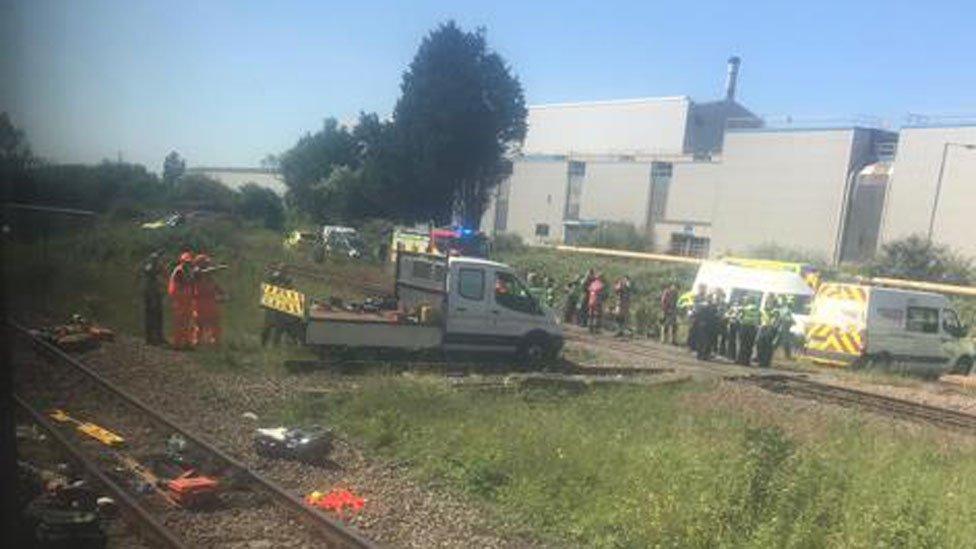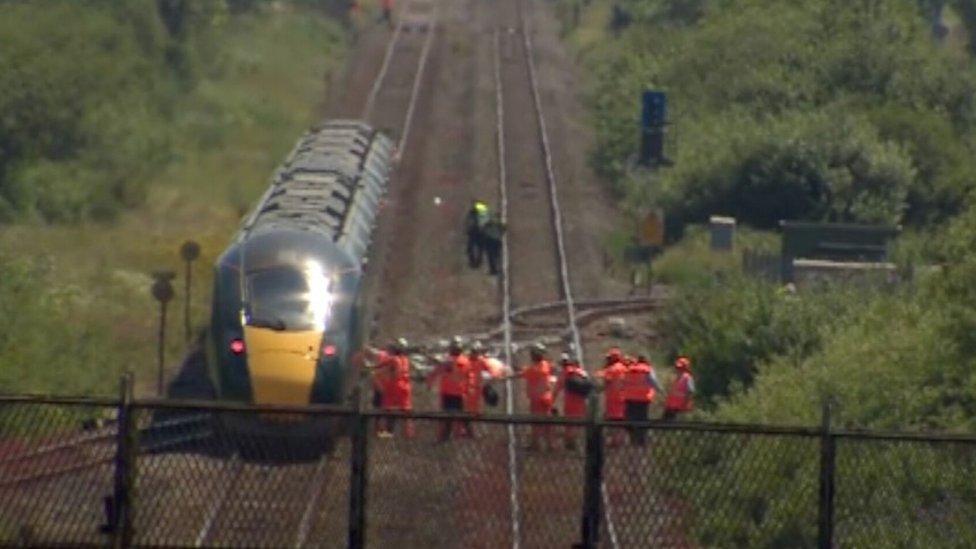Margam rail deaths: 'No safe system' when workers killed
- Published

Gareth Delbridge (L) and Michael Lewis (R) were hit by a train in July
There was "no safe system in place" when two rail workers were hit and killed by a train in July, an initial report has found.
Gareth Delbridge, 64, and Michael "Spike" Lewis, 58, died on 3 July after being struck near Margam, Port Talbot.
A Network Rail and Great Western Railway probe said six staff were working on the line and separated of their own accord into groups of three.
This meant there was no official lookout.
A person was appointed unofficial lookout, but they became involved in the rail work before the train struck Mr Delbridge, from Kenfig Hill, Bridgend and Mr Lewis, from North Cornelly, Bridgend.
The report said it was "generally accepted" groups can be about 20 yards apart during work, but the workers split and worked 150 yards apart.
The group was working with the line open to trains, with the lookout expected to give 30 seconds' warning time if a train was approaching, the report said.
But their distance apart compromised the number of lookouts available and a safe system of working.

A Swansea to London Paddington train approached the group at about 70mph, hitting and killing the two workers. A third technician suffered severe shock.
Horn sounded
The men had been instructed to work on freeing, oiling and retightening bolts by the unofficial person in charge, who was also to act as a lookout.
There was a problem with a bolt, meaning the lookout became involved in the rail work and suggested putting further oil on the bolt, despite being instructed to remain in a position of safety.
Soon afterwards, Mr Lewis and Mr Delbridge were struck.
The report added the team believed they were working in the "most effective way" with an experienced team and no evidence of near-misses or accidents.

An investigation was launched after the men were killed
This "potentially led to overconfidence and a culture that delivered work 'their way'," the report said, adding that the work they were undertaking should have required more than three members of staff.
The workers were, according to witness statements, all wearing ear defenders, and despite the train driver sounding the horn a number of times, they did not hear it.
The report said the driver used a high-low tone of train horn, before two long, continuous blasts in the low tone.

The train involved was the 09:29 from Swansea to London Paddington
However, the rule book said: "Give a series of short, urgent danger warnings to anyone…who does not…appear to move clear out of the way of the train."
The report said it was "uncertain" if using short high-tone warnings could have resulted in track workers becoming aware of the train earlier.
The report also found the controller of site safety (COSS) was "undermined" by the working group of six splitting into threes, and the COSS had not been involved in preparing the site before their arrival.
It stated the safe system of work was "inadequate" and resources were "insufficient" to apply a safe system of work after the larger group were divided.

About 180 passengers were on the train at the time of the incident, Great Western Railway said
Martin Frobisher, Network Rail's safety director, said: "The whole railway family shares the loss of Gareth and Spike.
"Nothing will lessen the pain but understanding what went wrong and learning from that will, I hope, go some way to reassure all those affected that we will do all we can to stop it ever happening again.
"Today is the first step in that journey as we share an initial investigation into what happened.
"We will continue for several months to look deeper into the root causes before we make recommendations for our organisation and all of our people for the future."
Investigators are continuing to gather evidence about the several factors of the report, including the appointment of key roles, the separation of groups, why the team undertook work on the crossing bolts and the intuitiveness in the use of the train warning horn in an emergency.
The interim report, which has not been finalised, added a series of investigated events over recent years had been identified, with some common circumstances to the key facts found at Margam East Junction.
- Published24 September 2019

- Published19 July 2019

- Published4 July 2019

- Published3 July 2019
